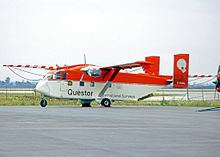Engine type Turboprop First flight January 17, 1963 | ||
 | ||
The Short SC.7 Skyvan (nicknamed the "Flying Shoebox") is a British 19-seat twin-turboprop aircraft manufactured by Short Brothers of Belfast, Northern Ireland. It is used mainly for short-haul freight and skydiving.
Contents
- Design and development
- Operational history
- Variants
- Civilian operators
- Military operators
- Former military operators
- Specification Skyvan 3
- References
The Skyvan is a high wing, twin-engined all-metal monoplane with a mid-mounted tailplane and twin rudders. The first flight of the Skyvan, the Skyvan 1, was on 17 January 1963. It is called "the shed" by pilots and crew.
The Short 330 and Short 360 are stretched models of the original SC.7, designed as regional airliners.
Design and development
In 1958, Shorts was approached by F.G. Miles Ltd (successor company to Miles Aircraft) which was seeking backing to produce a development of the H.D.M.106 Caravan design with a high aspect ratio wing similar to that of the Hurel-Dubois HD.31. Shorts acquired the design and data gathered from trials of the Miles Aerovan based H.D.M.105 prototype. After evaluating the Miles proposal, Shorts rejected the Caravan. They developed their own design for a utility all-metal aircraft which was called the Short SC.7 Skyvan. It was popular with freight operators compared to other small aircraft because of its large rear door for loading and unloading freight. Its fuselage resembles the shape of a railroad boxcar for simplicity and efficiency.
Construction started at Sydenham Airport in 1960, and the prototype first flew on 17 January 1963, powered by two Continental piston engines. Later in 1963, the prototype was re-engined with the intended Turbomeca Astazou turboprop engines. The Skyvan is an all-metal, high-wing monoplane, with a braced, high aspect ratio wing, and an unpressurised, square-section fuselage. In 1968, production switched to the Skyvan Series 3 aircraft, which replaced the Astazou engines with Garrett AiResearch TPE331 turboprops. A total of 153 Skyvans (plus the prototype) was produced before production ended in 1986.
Operational history
Skyvans served widely in both military and civilian operations, and the type remained in service in 2009 with a number of civilian operators, and in military service in Guyana and Oman.
In 1982, two Skyvans of the Argentine Naval Prefecture participated in the Falklands War. Both aircraft were ferried to Port Stanley in April 1982. One aircraft was damaged by British naval gunfire on Stanley racecourse, and did not fly again; it was finally destroyed by shellfire during British bombardments on 12/13 June 1982. The second aircraft was used at Pebble Island, where it became bogged down in the soft ground, and on 15 May 1982 it was destroyed in a British assault (see Raid on Pebble Island).
Skyvans continue to be used for air-to-air photography and for skydiving operations. In 1970, Questor Surveys of Toronto Canada converted the first of two Skyvan 3s for aerial geological survey work.
Variants
Civilian operators
As of July 2009, a total of 40 Skyvan aircraft remained in airline service, with Pink Aviation Services (5), Sonair (1), Swala Airlines (2), Transway Air Services (1), Deraya Air Taxi (3), Layang Layang Aerospace (1), Macair Airlines (1), Malaysia Air Charter (1), Olympic Airways (1), Pan Malaysian Air Transport (1), Wirakris Udara (1), CAE Aviation (1), Deltacraft (1), Invicta Aviation (2), Advanced Air (1), Allwest Freight (2), Era Alaska (3), GB Airlink (1), North Star Air Cargo (5), Skylift Taxi Aereo (1), Skydive Arizona (7), Skydive DeLand (1), Skydive Lonestar (1), Sydney Skydivers (2), Skydive Pennsylvania and Summit Air (2)., Sustut Air (1), Ryan Air Services, Nomad Air (2), Aalto-university-Finland.
Military operators
Former military operators
Specification (Skyvan 3)
Data from Jane's Civil and Military Upgrades 1994-95
General characteristics
Performance
